An Atlas of Piezoelectric Energy Harvesters in Oceanic Applications
Abstract
:1. Introduction
2. Oceanic Piezoelectric Energy Harvesters
2.1. Piezoelectricity
2.2. Piezoelectric Materials
2.3. Coupling Modes
2.4. Classification Based on Device Structure
2.5. Power Harvesting System
2.6. Ocean Energy Sources for Piezoelectric Energy Harvesters
2.6.1. Water Currents
2.6.2. Wave Motion
2.6.3. Wave Impact
2.7. Location
3. The ATLAS
4. Discussions and Research Needs
4.1. Configurations
4.2. Material
4.3. Coupling Modes
4.4. Energy Sources
4.5. Power
5. Conclusions
Author Contributions
Funding
Institutional Review Board Statement
Informed Consent Statement
Conflicts of Interest
References
- Albaladejo, C.; Sánchez, P.; Iborra, A.; Soto, F.; López, J.A.; Torres, R. Wireless Sensor Networks for Oceanographic Monitoring: A Systematic Review. Sensors 2010, 10, 6948. [Google Scholar] [CrossRef] [PubMed]
- Zhao, T.; Xu, M.; Xiao, X.; Ma, Y.; Li, Z.; Wang, Z.L. Recent progress in blue energy harvesting for powering distributed sensors in ocean. Nano Energy 2021, 88, 106199. [Google Scholar] [CrossRef]
- Gong, Y.; Yang, Z.; Shan, X.; Sun, Y.; Xie, T.; Zi, Y. Capturing Flow Energy from Ocean and Wind. Energies 2019, 12, 2184. [Google Scholar] [CrossRef] [Green Version]
- Liang, H.; Hao, G.; Olszewski, O.Z. A review on vibration-based piezoelectric energy harvesting from the aspect of compliant mechanisms. Sens. Actuators A Phys. 2021, 331, 112743. [Google Scholar] [CrossRef]
- Mustapa, M.A.; Yaakob, O.B.; Ahmed, Y.M.; Rheem, C.-K.; Koh, K.K.; Adnan, F.A. Wave energy device and breakwater integration: A review. Renew. Sustain. Energy Rev. 2017, 77, 43–58. [Google Scholar] [CrossRef]
- Bahaj, A.S. Generating electricity from the oceans. Renew. Sustain. Energy Rev. 2011, 15, 3399–3416. [Google Scholar] [CrossRef]
- Jouanne, A.V.; Brekken, T. Wave energy research, development and demonstration at Oregon State University. In Proceedings of the 2011 IEEE Power and Energy Society General Meeting, Detroit, MI, USA, 24–28 July 2011; pp. 1–7. [Google Scholar]
- De Sousa Prado, M.G.; Gardner, F.; Damen, M.; Polinder, H. Modelling and test results of the Archimedes wave swing. Proc. Inst. Mech. Eng. Part A J. Power Energy 2006, 220, 855–868. [Google Scholar] [CrossRef]
- Torre-Enciso, Y.; Ortubia, I.; De Aguileta, L.L.; Marqués, J. Mutriku wave power plant: From the thinking out to the reality. In Proceedings of the 8th European Wave and Tidal Energy Conference, Uppsala, Sweden, 7–10 September 2009; pp. 319–329. [Google Scholar]
- Kofoed, J.P.; Frigaard, P.; Friis-Madsen, E.; Sørensen, H.C. Prototype testing of the wave energy converter wave dragon. Renew. Energy 2006, 31, 181–189. [Google Scholar] [CrossRef] [Green Version]
- Jbaily, A.; Yeung, R.W. Piezoelectric devices for ocean energy: A brief survey. J. Ocean Eng. Mar. Energy 2015, 1, 101–118. [Google Scholar] [CrossRef] [Green Version]
- Despesse, G.; Chaillout, J.J.; Jager, T.; Léger, J.-M.; Vassilev, A.; Basrour, S.; Charlot, B. High damping electrostatic system for vibration energy scavenging. In Proceedings of the 2005 Joint Conference on Smart Objects and Ambient Intelligence: Innovative Context-Aware Services: Usages and Technologies, Grenoble, France, 12–14 October 2005; pp. 283–286. [Google Scholar]
- Mizuno, M.; Chetwynd, D.G. Investigation of a resonance microgenerator. J. Micromech. Microeng. 2003, 13, 209–216. [Google Scholar] [CrossRef]
- Shen, F.; Li, Z.; Guo, H.; Yang, Z.; Wu, H.; Wang, M.; Luo, J.; Xie, S.; Peng, Y.; Pu, H. Recent Advances towards Ocean Energy Harvesting and Self-Powered Applications Based on Triboelectric Nanogenerators. Adv. Electron. Mater. 2021, 7, 2100277. [Google Scholar] [CrossRef]
- Jahanbakht, M.; Xiang, W.; Hanzo, L.; Azghadi, M.R. Internet of Underwater Things and Big Marine Data Analytics—A Comprehensive Survey. IEEE Commun. Surv. Tutor. 2021, 23, 904–956. [Google Scholar] [CrossRef]
- Priya, S. Advances in energy harvesting using low profile piezoelectric transducers. J. Electroceram. 2007, 19, 167–184. [Google Scholar] [CrossRef]
- Moure, A.; Izquierdo Rodríguez, M.A.; Rueda, S.H.; Gonzalo, A.; Rubio-Marcos, F.; Cuadros, D.U.; Pérez-Lepe, A.; Fernández, J.F. Feasible integration in asphalt of piezoelectric cymbals for vibration energy harvesting. Energy Convers. Manag. 2016, 112, 246–253. [Google Scholar] [CrossRef]
- Kim, K.-B.; Cho, J.Y.; Jabbar, H.; Ahn, J.H.; Hong, S.D.; Woo, S.B.; Sung, T.H. Optimized composite piezoelectric energy harvesting floor tile for smart home energy management. Energy Convers. Manag. 2018, 171, 31–37. [Google Scholar] [CrossRef]
- Wang, Z.; Tan, L.; Pan, X.; Liu, G.; He, Y.; Jin, W.; Li, M.; Hu, Y.; Gu, H. Self-Powered Viscosity and Pressure Sensing in Microfluidic Systems Based on the Piezoelectric Energy Harvesting of Flowing Droplets. ACS Appl. Mater. Interfaces 2017, 9, 28586–28595. [Google Scholar] [CrossRef]
- Zaszczynska, A.; Sajkiewicz, P.; Gradys, A. Piezoelectric Scaffolds as Smart Materials for Neural Tissue Engineering. Polymers 2020, 12, 161. [Google Scholar] [CrossRef] [Green Version]
- Deng, W.; Yang, T.; Jin, L.; Yan, C.; Huang, H.; Chu, X.; Wang, Z.; Xiong, D.; Tian, G.; Gao, Y.; et al. Cowpea-structured PVDF/ZnO nanofibers based flexible self-powered piezoelectric bending motion sensor towards remote control of gestures. Nano Energy 2019, 55, 516–525. [Google Scholar] [CrossRef]
- Zhang, H.; Zhang, X.S.; Cheng, X.; Liu, Y.; Han, M.; Xue, X.; Wang, S.; Yang, F.; Smitha, A.S.; Zhang, H.; et al. A flexible and implantable piezoelectric generator harvesting energy from the pulsation of ascending aorta: In vitro and in vivo studies. Nano Energy 2015, 12, 296–304. [Google Scholar] [CrossRef]
- Orrego, S.; Shoele, K.; Ruas, A.; Doran, K.; Caggiano, B.; Mittal, R.; Kang, S.H. Harvesting ambient wind energy with an inverted piezoelectric flag. Appl. Energy 2017, 194, 212–222. [Google Scholar] [CrossRef]
- Nabavi, S.F.; Farshidianfar, A.; Afsharfard, A.; Khodaparast, H.H. An ocean wave-based piezoelectric energy harvesting system using breaking wave force. Int. J. Mech. Sci. 2019, 151, 498–507. [Google Scholar] [CrossRef] [Green Version]
- Zurkinden, A.S.; Campanile, F.C.; Martinelli, L. Wave Energy Converter through Piezoelectric Polymers. In Proceedings of the Proceedings of the COMSOL Users Conference 2007, Grenoble, France, 23–24 October 2007. [Google Scholar]
- Viet, N.V.; Wu, N.; Wang, Q. A review on energy harvesting from ocean waves by piezoelectric technology. J. Model. Mech. Mater. 2017, 1, 20160161. [Google Scholar] [CrossRef]
- Kim, H.-M. Electroactive polymers for ocean kinetic energy harvesting: Literature review and research needs. J. Ocean Eng. Mar. Energy 2018, 4, 343–365. [Google Scholar] [CrossRef]
- Kiran, M.R.; Farrok, O.; Abdullah-Al-Mamun, M.; Islam, M.R.; Xu, W. Progress in Piezoelectric Material Based Oceanic Wave Energy Conversion Technology. IEEE Access 2020, 8, 146428–146449. [Google Scholar] [CrossRef]
- Hamlehdar, M.; Kasaeian, A.; Safaei, M.R. Energy harvesting from fluid flow using piezoelectrics: A critical review. Renew. Energy 2019, 143, 1826–1838. [Google Scholar] [CrossRef]
- Curie, P.; Curie, J. Développement par compression de l’électricité polaire dans les cristaux hémièdres à faces inclinées. Bull. Minéralogie 1880, 3, 90–93. [Google Scholar] [CrossRef]
- Sezer, N.; Koç, M. A comprehensive review on the state-of-the-art of piezoelectric energy harvesting. Nano Energy 2021, 80, 105567. [Google Scholar] [CrossRef]
- Anton, S.R.; Sodano, H.A. A review of power harvesting using piezoelectric materials (2003–2006). Smart Mater. Struct. 2007, 16, R1–R21. [Google Scholar] [CrossRef]
- Liu, H.; Zhong, J.; Lee, C.; Lee, S.-W.; Lin, L. A comprehensive review on piezoelectric energy harvesting technology: Materials, mechanisms, and applications. Appl. Phys. Rev. 2018, 5, 041306. [Google Scholar] [CrossRef]
- Aabid, A.; Raheman, M.A.; Ibrahim, Y.E.; Anjum, A.; Hrairi, M.; Parveez, B.; Parveen, N.; Mohammed Zayan, J. A Systematic Review of Piezoelectric Materials and Energy Harvesters for Industrial Applications. Sensors 2021, 21, 4145. [Google Scholar] [CrossRef]
- Covaci, C.; Gontean, A. Piezoelectric Energy Harvesting Solutions: A Review. Sensors 2020, 20, 3512. [Google Scholar] [CrossRef] [PubMed]
- Mishra, S.; Unnikrishnan, L.; Nayak, S.K.; Mohanty, S. Advances in Piezoelectric Polymer Composites for Energy Harvesting Applications: A Systematic Review. Macromol. Mater. Eng. 2019, 304, 1800463. [Google Scholar] [CrossRef] [Green Version]
- Guyomar, D.; Badel, A.; Lefeuvre, E.; Richard, C. Toward energy harvesting using active materials and conversion improvement by nonlinear processing. IEEE Trans. Ultrason. Ferroelectr. Freq. Control 2005, 52, 584–595. [Google Scholar] [CrossRef] [PubMed] [Green Version]
- Shu, Y.C.; Lien, I.C. A comparison between the standard and SSHI interfaces used in piezoelectric power harvesting. In Active & Passive Smart Structures and Integrated Systems; International Society of Photo Optical: Bellingham, WA, USA, 2007; Volume 6525, p. 652509. [Google Scholar]
- Rathod, V.T. A Review of Electric Impedance Matching Techniques for Piezoelectric Sensors, Actuators and Transducers. Electronics 2019, 8, 169. [Google Scholar] [CrossRef] [Green Version]
- Liang, J.; Liao, W.H. Impedance matching for improving piezoelectric energy harvesting systems. In Active and Passive Smart Structures and Integrated Systems 2010; SPIE: Bellingham, WA, USA, 2010; Volume 7643, pp. 181–192. [Google Scholar]
- Wang, M.; Xia, Y.; Pu, H.; Sun, Y.; Ding, J.; Luo, J.; Xie, S.; Peng, Y.; Zhang, Q.; Li, Z. Piezoelectric Energy Harvesting from Suspension Structures with Piezoelectric Layers. Sensors 2020, 20, 3755. [Google Scholar] [CrossRef]
- Jabbar, H.; Jung, H.J.; Chen, N.; Cho, D.H.; Sung, T.H. Piezoelectric energy harvester impedance matching using a piezoelectric transformer. Sens. Actuators A Phys. 2017, 264, 141–150. [Google Scholar] [CrossRef]
- López, I.; Andreu, J.; Ceballos, S.; Martínez de Alegría, I.; Kortabarria, I. Review of wave energy technologies and the necessary power-equipment. Renew. Sustain. Energy Rev. 2013, 27, 413–434. [Google Scholar] [CrossRef]
- Jiang, B.; Li, X.; Chen, S.; Xiong, Q.; Chen, B.-F.; Parker, R.G.; Zuo, L. Performance analysis and tank test validation of a hybrid ocean wave-current energy converter with a single power takeoff. Energy Convers. Manag. 2020, 224, 113268. [Google Scholar] [CrossRef]
- Yeung, R. Fluid Dynamics of Finned Bodies—From VIV to FPSO. In Proceedings of the The Twelfth International Offshore and Polar Engineering Conference, Kitakyushu, Japan, 26 May 2002; Volume 12. [Google Scholar]
- Akcabay, D.; Young, Y.L. Hydroelastic response and energy harvesting potential of flexible piezoelectric beams in viscous flow. Phys. Fluids 2012, 24, 054106. [Google Scholar] [CrossRef]
- Toffoli, A.; Bitner-Gregersen, E.M. Types of Ocean Surface Waves, Wave Classification. In Encyclopedia of Maritime and Offshore Engineering; Carlton, J., Jukes, P., Choo, Y.S., Eds.; Wiley: Hoboken, NJ, USA, 2017; pp. 1–8. [Google Scholar] [CrossRef]
- Guillou, N. Estimating wave energy flux from significant wave height and peak period. Renew. Energy 2020, 155, 1383–1393. [Google Scholar] [CrossRef]
- Akimoto, H.; Tanaka, K.; Kim, Y.Y. Drag-type cross-flow water turbine for capturing energy from the orbital fluid motion in ocean wave. Renew. Energy 2015, 76, 196–203. [Google Scholar] [CrossRef]
- Athanassoulis, G.A.; Mamis, K.I. Modeling and analysis of a cliff-mounted piezoelectric sea-wave energy absorption system. Coupled Syst. Mech. 2013, 2, 53–83. [Google Scholar] [CrossRef]
- Farrok, O.; Ahmed, K.; Tahlil, A.D.; Farah, M.M.; Kiran, M.R.; Islam, M.R. Electrical Power Generation from the Oceanic Wave for Sustainable Advancement in Renewable Energy Technologies. Sustainability 2020, 12, 2178. [Google Scholar] [CrossRef] [Green Version]
- Hausler, E.; Stein, L. Hydromechanical and physiological mechanical-to-electrical power converter with PVDF film. Ferroelectrics 1987, 75, 363–369. [Google Scholar] [CrossRef]
- Burns, J.R. Ocean Wave Energy Conversion Using Piezoelectric Material Members. U.S. Patent 4,685,296, 11 August 1987. [Google Scholar]
- Taylor, G.W.; Burns, J.R.; Kammann, S.A.; Powers, W.B.; Welsh, T.R. The Energy Harvesting Eel: A small subsurface ocean/river power generator. IEEE J. Ocean. Eng. 2001, 26, 539–547. [Google Scholar] [CrossRef] [Green Version]
- Pobering, S.; Schwesinger, N. A Novel Hydropower Harvesting Device. In Proceedings of the 2004 International Conference on MEMS, NANO and Smart Systems (ICMENS’04), Banff, AB, Canada, 25–27 August 2004; pp. 480–485. [Google Scholar]
- Murray, R.; Rastegar, J. Novel two-stage piezoelectric-based ocean wave energy harvesters for moored or unmoored buoys. In Active and Passive Smart Structures and Integrated Systems 2009; SPIE: Bellingham, WA, USA, 2009; Volume 7288, pp. 184–195. [Google Scholar]
- Mutsuda, H.; Kawakami, K.; Kurokawa, T.; Doi, Y.; Tanaka, Y. A Technology of Electrical Energy Generated From Ocean Power Using Flexible Piezoelectric Device. In Proceedings of the ASME 2010 29th International Conference on Ocean, Offshore and Arctic Engineering, Shanghai, China, 6–11 June 2010; pp. 313–321. [Google Scholar]
- Mutsuda, H.; Kawakami, K.; Hirata, M.; Doi, Y.; Tanaka, Y. Study on Wave Power Generator Using Flexible Piezoelectric Device. In Proceedings of the ASME 2011 30th International Conference on Ocean, Offshore and Arctic Engineering, Rotterdam, The Netherlands, 19–24 June 2011; pp. 267–273. [Google Scholar]
- Mutsuda, H.; Watanabe, R.; Hirata, M.; Doi, Y.; Tanaka, Y. Elastic Floating Unit With Piezoelectric Device for Harvesting Ocean Wave Energy. In Proceedings of the ASME 2012 31st International Conference on Ocean, Offshore and Arctic Engineering, Rio de Janeiro, Brazil, 1–6 July 2012; pp. 233–240. [Google Scholar]
- Mutsuda, H.; Watanabe, R.; Azuma, S.; Tanaka, Y.; Doi, Y. Ocean Power Generator Using Flexible Piezoelectric Device. In Proceedings of the ASME 2013 32nd International Conference on Ocean, Offshore and Arctic Engineering, Nantes, France, 9–14 June 2013. [Google Scholar]
- Molino-Minero-Re, E.; Carbonell-Ventura, M.; Fisac-Fuentes, C.; Mànuel-Làzaro, A.; Toma, D.M. Piezoelectric energy harvesting from induced vortex in water flow. In Proceedings of the 2012 IEEE International Instrumentation and Measurement Technology Conference Proceedings, Graz, Austria, 13–16 May 2012; pp. 624–627. [Google Scholar]
- Okada, N.; Fujimoto, H.; Yabe, S.; Murai, M. Experiments on floating wave-power generation using piezoelectric elements and pendulums in the water tank. In Proceedings of the the 2012 Oceans—Yeosu, Yeosu, Korea, 21–24 May 2012; pp. 1–8. [Google Scholar]
- Kim, K.-B.; Kim, C.I.; Jeong, Y.H.; Cho, J.-H.; Paik, J.-H.; Nahm, S.; Lim, J.B.; Seong, T.-H. Energy Harvesting Characteristics from Water Flow by Piezoelectric Energy Harvester Device Using Cr/Nb Doped Pb(Zr,Ti)O3Bimorph Cantilever. Jpn. J. Appl. Phys. 2013, 52, 10MB01. [Google Scholar] [CrossRef]
- Xie, X.D.; Wang, Q.; Wu, N. Potential of a piezoelectric energy harvester from sea waves. J. Sound Vib. 2014, 333, 1421–1429. [Google Scholar] [CrossRef]
- Xie, X.D.; Wang, Q.; Wu, N. Energy harvesting from transverse ocean waves by a piezoelectric plate. Int. J. Eng. Sci. 2014, 81, 41–48. [Google Scholar] [CrossRef]
- Woo, M.S.; Baek, K.H.; Kim, J.H.; Kim, S.B.; Song, D.; Sung, T.H. Relationship between current and impedance in piezoelectric energy harvesting system for water waves. J. Electroceram. 2015, 34, 180–184. [Google Scholar] [CrossRef]
- Gao, X.; Xu, Z.; Gu, J.; Pan, F.; Dong, X. A study of piezoelectric generator based on the flow around a blunt body. In Proceedings of the 2014 17th International Conference on Electrical Machines and Systems (ICEMS), Hangzhou, China, 22–25 October 2014; pp. 2877–2881. [Google Scholar]
- Song, R.; Shan, X.; Lv, F.; Li, J.; Xie, T. A Novel Piezoelectric Energy Harvester Using the Macro Fiber Composite Cantilever with a Bicylinder in Water. Appl. Sci. 2015, 5, 1942. [Google Scholar] [CrossRef] [Green Version]
- Song, R.; Shan, X.; Lv, F.; Xie, T. A study of vortex-induced energy harvesting from water using PZT piezoelectric cantilever with cylindrical extension. Ceram. Int. 2015, 41, S768–S773. [Google Scholar] [CrossRef]
- Sarker, M.R.; Mohamed, A.; Mohamed, R. Cantilever beam vibration from fluid interactions with triangular shape blunt body for energy harvesting application. In Proceedings of the 2015 IEEE Student Conference on Research and Development (SCOReD), Kuala Lumpur, Malaysia, 13–14 December 2015; pp. 6–10. [Google Scholar]
- Feifei, P.; Zhike, X.; Long, J.; Xiu, G. Designed simulation and experiment of a piezoelectric energy harvesting system based on flow around blunt bodies. In Proceedings of the 2015 18th International Conference on Electrical Machines and Systems (ICEMS), Pattaya, Thailand, 25–28 October 2015; pp. 2104–2107. [Google Scholar]
- Shan, X.; Song, R.; Liu, B.; Xie, T. Novel energy harvesting: A macro fiber composite piezoelectric energy harvester in the water vortex. Ceram. Int. 2015, 41, S763–S767. [Google Scholar] [CrossRef]
- Wu, N.; Wang, Q.; Xie, X. Ocean wave energy harvesting with a piezoelectric coupled buoy structure. Appl. Ocean Res. 2015, 50, 110–118. [Google Scholar] [CrossRef]
- Toma, D.M.; del Rio, J.; Carbonell-Ventura, M.; Masalles, J.M. Underwater energy harvesting system based on plucked-driven piezoelectrics. In Proceedings of the OCEANS 2015—Genova, Genova, Italy, 18–21 May 2015; pp. 1–5. [Google Scholar]
- Cha, Y.; Chae, W.; Kim, H.; Walcott, H.; Peterson, S.D.; Porfiri, M. Energy harvesting from a piezoelectric biomimetic fish tail. Renew. Energy 2016, 86, 449–458. [Google Scholar] [CrossRef] [Green Version]
- Li, H.; Tian, C.; Lu, J.; Myjak, M.J.; Martinez, J.J.; Brown, R.S.; Deng, Z.D. An Energy Harvesting Underwater Acoustic Transmitter for Aquatic Animals. Sci. Rep. 2016, 6, 33804. [Google Scholar] [CrossRef] [PubMed] [Green Version]
- Viet, N.V.; Xie, X.D.; Liew, K.M.; Banthia, N.; Wang, Q. Energy harvesting from ocean waves by a floating energy harvester. Energy 2016, 112, 1219–1226. [Google Scholar] [CrossRef]
- Kamenar, E.; Zelenika, S.; Blažević, D.; Maćešić, S.; Gregov, G.; Marković, K.; Glažar, V. Harvesting of river flow energy for wireless sensor network technology. Microsyst. Technol. 2016, 22, 1557–1574. [Google Scholar] [CrossRef]
- Renzi, E. Hydroelectromechanical modelling of a piezoelectric wave energy converter. Proc. R. Soc. A Math. Phys. Eng. Sci. 2016, 472, 20160715. [Google Scholar] [CrossRef] [Green Version]
- Mutsuda, H.; Tanaka, Y.; Patel, R.; Doi, Y.; Moriyama, Y.; Umino, Y. A painting type of flexible piezoelectric device for ocean energy harvesting. Appl. Ocean Res. 2017, 68, 182–193. [Google Scholar] [CrossRef]
- Shan, X.; Deng, J.; Song, R.; Xie, T. A Piezoelectric Energy Harvester with Bending–Torsion Vibration in Low-Speed Water. Appl. Sci. 2017, 7, 116. [Google Scholar] [CrossRef]
- Xie, X.D.; Wang, Q. A study on an ocean wave energy harvester made of a composite piezoelectric buoy structure. Compos. Struct. 2017, 178, 447–454. [Google Scholar] [CrossRef]
- Hwang, W.S.; Ahn, J.H.; Jeong, S.Y.; Jung, H.J.; Hong, S.K.; Choi, J.Y.; Cho, J.Y.; Kim, J.H.; Sung, T.H. Design of piezoelectric ocean-wave energy harvester using sway movement. Sens. Actuators A Phys. 2017, 260, 191–197. [Google Scholar] [CrossRef]
- Viet, N.V.; Wang, Q.; Carpinteri, A. Development of an ocean wave energy harvester with a built-in frequency conversion function. Int. J. Energy Res. 2018, 42, 684–695. [Google Scholar] [CrossRef]
- An, X.; Song, B.; Tian, W.; Ma, C. Numerical simulation of Vortex Induced Piezoelectric Energy Converter (VIPEC) based on coupled fluid, structure and piezoelectric interaction. In Proceedings of the OCEANS 2017—Aberdeen, Aberdeen, UK, 19–22 June 2017; pp. 1–5. [Google Scholar]
- An, X.; Song, B.; Tian, W.; Ma, C. Design and CFD Simulations of a Vortex-Induced Piezoelectric Energy Converter (VIPEC) for Underwater Environment. Energies 2018, 11, 330. [Google Scholar] [CrossRef] [Green Version]
- Dessi, D.; Leonardi, G.; Passacantilli, F. Energy Harvesting From Waves Using Piezoelectric Floaters. In Proceedings of the ASME 2018 37th International Conference on Ocean, Offshore and Arctic Engineering, Madrid, Spain, 17–22 June 2018. [Google Scholar]
- Nabavi, S.F.; Farshidianfar, A.; Afsharfard, A. Novel piezoelectric-based ocean wave energy harvesting from offshore buoys. Appl. Ocean Res. 2018, 76, 174–183. [Google Scholar] [CrossRef]
- Nguyen, V.; Wang, Q. Ocean Wave Energy Pitching Harvester with a Frequency Tuning Capability. Energy 2018, 162, 603–617. [Google Scholar] [CrossRef]
- Salazar, R.; Taylor, G.; Khalid, M.S.U.; Abdelkefi, A. Optimal design and energy harvesting performance of carangiform fish-like robotic system. Smart Mater. Struct. 2018, 27, 075045. [Google Scholar] [CrossRef]
- Aramendia, I.; Fernandez-Gamiz, U.; Zulueta Guerrero, E.; Lopez-Guede, J.M.; Sancho, J. Power Control Optimization of an Underwater Piezoelectric Energy Harvester. Appl. Sci. 2018, 8, 389. [Google Scholar] [CrossRef] [Green Version]
- Ming, L.; Hengxu, L.; Hailong, C.; Yuanchao, C.; Liquan, W. Performance Analysis for a Wave Energy Harvester of Piezoelectric Cantilever Beam. J. Coast. Res. 2019, 83, 976–984. [Google Scholar] [CrossRef]
- Gong, Y.; Shan, X.; Yang, Z.; Xie, T. 270-degree arc-shaped piezoelectric energy converter in uniflow fluid environment. IOP Conf. Ser. Mater. Sci. Eng. 2019, 531, 012026. [Google Scholar] [CrossRef]
- Viet, N.V.; Carpinteri, A.; Wang, Q. A Novel Heaving Ocean Wave Energy Harvester with a Frequency Tuning Capability. Arab. J. Sci. Eng. 2019, 44, 5711–5722. [Google Scholar] [CrossRef]
- Bao, B.; Chen, W.; Wang, Q. A piezoelectric hydro-energy harvester featuring a special container structure. Energy 2019, 189, 116261. [Google Scholar] [CrossRef]
- Zhang, J.; Xie, X.; Song, G.; Du, G.; Liu, D. A study on a near-shore cantilevered sea wave energy harvester with a variable cross section. Energy Sci. Eng. 2019, 7, 3174–3185. [Google Scholar] [CrossRef]
- Mutsuda, H.; Tanaka, Y.; Doi, Y.; Moriyama, Y. Application of a flexible device coating with piezoelectric paint for harvesting wave energy. Ocean Eng. 2019, 172, 170–182. [Google Scholar] [CrossRef]
- Gong, Y.; Shan, X.; Luo, X.; Pan, J.; Xie, T.; Yang, Z. Direction-adaptive energy harvesting with a guide wing under flow-induced oscillations. Energy 2019, 187, 115983. [Google Scholar] [CrossRef]
- Sun, W.; Zhao, D.; Tan, T.; Yan, Z.; Guo, P.; Luo, X. Low velocity water flow energy harvesting using vortex induced vibration and galloping. Appl. Energy 2019, 251, 113392. [Google Scholar] [CrossRef]
- Shan, X.; Li, H.; Yang, Y.; Feng, J.; Wang, Y.; Xie, T. Enhancing the performance of an underwater piezoelectric energy harvester based on flow-induced vibration. Energy 2019, 172, 134–140. [Google Scholar] [CrossRef]
- Noh, H.-J.; Lee, J.-S.; Kim, Y.-J. Micro-energy harvesting based on vortex-induced vibration of cross-flow hydroturbine with various cantilever beam configurations. IOP Conf. Ser. Earth Environ. Sci. 2019, 240, 022034. [Google Scholar] [CrossRef]
- Liu, H.-X.; Liu, M.; Chai, Y.-C.; Shu, G.-Y.; Jing, F.-M.; Wang, L.-Q. Piezoelectric Energy Analysis on Diverse Buoy Coupling with Hydrodynamic Parameters. China Ocean Eng. 2019, 33, 279–287. [Google Scholar] [CrossRef]
- Yayla, S.; Ayça, S.; Oruç, M. A case study on piezoelectric energy harvesting with using vortex generator plate modeling for fluids. Renew. Energy 2020, 157, 1243–1253. [Google Scholar] [CrossRef]
- Cao, D.; Ding, X.; Guo, X.; Yao, M. Design, Simulation and Experiment for a Vortex-Induced Vibration Energy Harvester for Low-Velocity Water Flow. Int. J. Precis. Eng. Manuf.-Green Technol. 2021, 8, 1239–1252. [Google Scholar] [CrossRef]
- Shan, X.; Tian, H.; Xie, T. Enhanced performance of piezoelectric energy harvester through three serial vibrators. J. Intell. Mater. Syst. Struct. 2020, 32, 1140–1151. [Google Scholar] [CrossRef]
- Du, X.; Zhao, Y.; Liu, G.; Zhang, M.; Wang, Y.; Yu, H. Enhancement of the Piezoelectric Cantilever Beam Performance via Vortex-Induced Vibration to Harvest Ocean Wave Energy. Shock Vib. 2020, 2020, 8858529. [Google Scholar] [CrossRef]
- Latif, U.; Ali, E.; Uddin, E.; Ali, Z.; Sajid, M.; Shah, S.R.; Younis, M.Y. Experimental investigation of energy harvesting eel in the wake of bluff body under ocean waves. Proc. Inst. Mech. Eng. Part M J. Eng. Marit. Environ. 2020, 235, 81–92. [Google Scholar] [CrossRef]
- Kim, S.; Cho, J.Y.; Jeon, D.H.; Hwang, W.; Song, Y.; Jeong, S.Y.; Jeong, S.W.; Yoo, H.H.; Sung, T.H. Propeller-based Underwater Piezoelectric Energy Harvesting System for an Autonomous IoT Sensor System. J. Korean Phys. Soc. 2020, 76, 251–256. [Google Scholar] [CrossRef]
- Qi, L.; Li, H.; Wu, X.; Zhang, Z.; Duan, W.; Yi, M. A hybrid piezoelectric-electromagnetic wave energy harvester based on capsule structure for self-powered applications in sea-crossing bridges. Renew. Energy 2021, 178, 1223–1235. [Google Scholar] [CrossRef]
- Bao, B.; Wang, Q. Bladeless rotational piezoelectric energy harvester for hydroelectric applications of ultra-low and wide-range flow rates. Energy Convers. Manag. 2021, 227, 113619. [Google Scholar] [CrossRef]
- Kazemi, S.; Nili-Ahmadabadi, M.; Tavakoli, M.R.; Tikani, R. Energy harvesting from longitudinal and transverse motions of sea waves particles using a new waterproof piezoelectric waves energy harvester. Renew. Energy 2021, 179, 528–536. [Google Scholar] [CrossRef]
- Zhao, D.; Zhou, J.; Tan, T.; Yan, Z.; Sun, W.; Yin, J.; Zhang, W. Hydrokinetic piezoelectric energy harvesting by wake induced vibration. Energy 2021, 220, 119722. [Google Scholar] [CrossRef]
- Jiao, P.; Yang, Y.; Egbe, K.I.; He, Z.; Lin, Y. Mechanical Metamaterials Gyro-Structure Piezoelectric Nanogenerators for Energy Harvesting under Quasi-Static Excitations in Ocean Engineering. ACS Omega 2021, 6, 15348–15360. [Google Scholar] [CrossRef]
- Song, R.; Hou, C.; Yang, C.; Yang, X.; Guo, Q.; Shan, X. Modeling, Validation, and Performance of Two Tandem Cylinder Piezoelectric Energy Harvesters in Water Flow. Micromachines 2021, 12, 872. [Google Scholar] [CrossRef] [PubMed]
- Mariello, M.; Fachechi, L.; Guido, F.; De Vittorio, M. Multifunctional sub-100 µm thickness flexible piezo/triboelectric hybrid water energy harvester based on biocompatible AlN and soft parylene C-PDMS-Ecoflex™. Nano Energy 2021, 83, 105811. [Google Scholar] [CrossRef]
- Ucar, H. Patch-based piezoelectric energy harvesting on a marine boat exposed to wave-induced loads. Ocean Eng. 2021, 236, 109568. [Google Scholar] [CrossRef]
- Zheng, S.; Meylan, M.; Zhang, X.; Iglesias, G.; Greaves, D. Performance of a plate-wave energy converter integrated in a floating breakwater. IET Renew. Power Gener. 2021, 15, 3206–3219. [Google Scholar] [CrossRef]
- Salazar, R.; Quintana, R.; Abdelkefi, A. Role of Electromechanical Coupling, Locomotion Type and Damping on the Effectiveness of Fish-Like Robot Energy Harvesters. Energies 2021, 14, 693. [Google Scholar] [CrossRef]
- Yulianti, S.; Kevin, P.; Prakoso, A. The Use of Piezoelectric as Energy Harvester in Breakwater. IOP Conf. Ser. Earth Environ. Sci. 2021, 750, 012016. [Google Scholar] [CrossRef]
- Du, X.; Zhang, M.; Kang, H.; Chang, H.; Yu, H. Theoretical study on a novel piezoelectric ocean wave energy harvester driven by oscillating water column. Energy Sources Part A Recovery Util. Environ. Eff. 2021, 1–21. [Google Scholar] [CrossRef]
- Alizzio, D.; Bonfanti, M.; Donato, N.; Faraci, C.; Grasso, G.M.; Lo Savio, F.; Montanini, R.; Quattrocchi, A. Design and Performance Evaluation of a “Fixed-Point” Spar Buoy Equipped with a Piezoelectric Energy Harvesting Unit for Floating Near-Shore Applications. Sensors 2021, 21, 1912. [Google Scholar] [CrossRef]
- Tan, D.; Wang, Y.-C.; Kohtanen, E.; Erturk, A. Trout-like multifunctional piezoelectric robotic fish and energy harvester. Bioinspir. Biomim. 2021, 16, 046024. [Google Scholar] [CrossRef]
- Wang, D.A.; Ko, H.H. Piezoelectric energy harvesting from flow-induced vibration. J. Micromech. Microeng. Struct. Devices Syst. 2010, 20, 025019. [Google Scholar] [CrossRef]
- Wang, D.-A.; Liu, N.-Z. A shear mode piezoelectric energy harvester based on a pressurized water flow. Sens. Actuators A Phys. 2011, 167, 449–458. [Google Scholar] [CrossRef]
- Toma, D.M.; Ventura, M.C.; Bresco, D.P.; Lázaro, A.M.; Masalles, J.M. An impacting energy harvester through piezoelectric device for oscillating water flow. In Proceedings of the MARTECH 2013: 5th International Workshop on Marine Technology, Vilanova i la Geltrú, Spain, 19–20 November 2013. [Google Scholar]
- Viñolo, C.; Toma, D.M.; Manuel, A.; del Río, J. Sea motion electrical energy generator for low-power applications. In Proceedings of the 2013 MTS/IEEE OCEANS—Bergen, Bergen, Norway, 10–14 June 2013; pp. 1–7. [Google Scholar]
- Viñolo, C.; Toma, D.; Mànuel, A.; del Rio, J. An ocean kinetic energy converter for low-power applications using piezoelectric disk elements. Eur. Phys. J. Spec. Top. 2013, 222, 1685–1698. [Google Scholar] [CrossRef]
- Abrol, S.; Chhabra, D.; Chhabra, D. Experimental Investigations of Piezoelectric Energy Harvesting with Turbulent Flow. Int. J. Mech. Prod. Eng. Res. Dev. 2018, 8, 703–710. [Google Scholar] [CrossRef]
- Huang, W.; Huang, Y. A Study on Piezoelectric Buoy Energy Harvester Based on Orthogonal Experimental Design. In Proceedings of the 2019 IEEE International Conference on Power, Intelligent Computing and Systems (ICPICS), Shenyang, China, 12–14 July 2019; pp. 611–614. [Google Scholar]
- Zhang, B.; Ducharne, B.; Gupta, B.; Sebald, G.; Guyomar, D.; Gao, J. Experimental sea wave energy extractor based on piezoelectric Ericsson cycles. J. Intell. Mater. Syst. Struct. 2017, 29, 1102–1112. [Google Scholar] [CrossRef]
- Chen, S.-E.; Yang, R.-Y.; Wu, G.-K.; Wu, C.-C. A Piezoelectric Wave-Energy Converter Equipped with a Geared-Linkage-Based Frequency Up-Conversion Mechanism. Sensors 2021, 21, 204. [Google Scholar] [CrossRef]
- Bezanson, L.; Thornton, J.; Konchuba, N.; Priya, S. Utilizing deep ocean currents to power extended duration sensors. In Proceedings of the OCEANS 2010 MTS/IEEE SEATTLE, Seattle, WA, USA, 20–23 September 2010; pp. 1–8. [Google Scholar]
- Zou, H.-X.; Li, M.; Zhao, L.-C.; Gao, Q.-H.; Wei, K.-X.; Zuo, L.; Qian, F.; Zhang, W.-M. A magnetically coupled bistable piezoelectric harvester for underwater energy harvesting. Energy 2021, 217, 119429. [Google Scholar] [CrossRef]
- Freris, L.; Infield, D. Renewable Energy in Power Systems; Wiley: Hoboken, NJ, USA, 2008. [Google Scholar]
- Li, H.; Tian, C.; Deng, Z.D. Energy harvesting from low frequency applications using piezoelectric materials. Appl. Phys. Rev. 2014, 1, 041301. [Google Scholar] [CrossRef] [Green Version]
- Shrout, T.R.; Zhang, S.J. Lead-free piezoelectric ceramics: Alternatives for PZT? J. Electroceram. 2007, 19, 113–126. [Google Scholar] [CrossRef]
- Shen, D.; Choe, S.-Y.; Kim, D.-J. Comparison of Piezoelectric Materials for Vibration Energy Conversion Devices. MRS Online Proc. Libr. 2011, 966, 734. [Google Scholar] [CrossRef]
- Pradhan, S.K.; Kumar, A.; Kour, P.; Pandey, R.; Kumar, P.; Kar, M.; Sinha, A.N. Piezoelectric and mechanical properties of PVDF-PZT composite. Ferroelectrics 2020, 558, 59–66. [Google Scholar] [CrossRef]


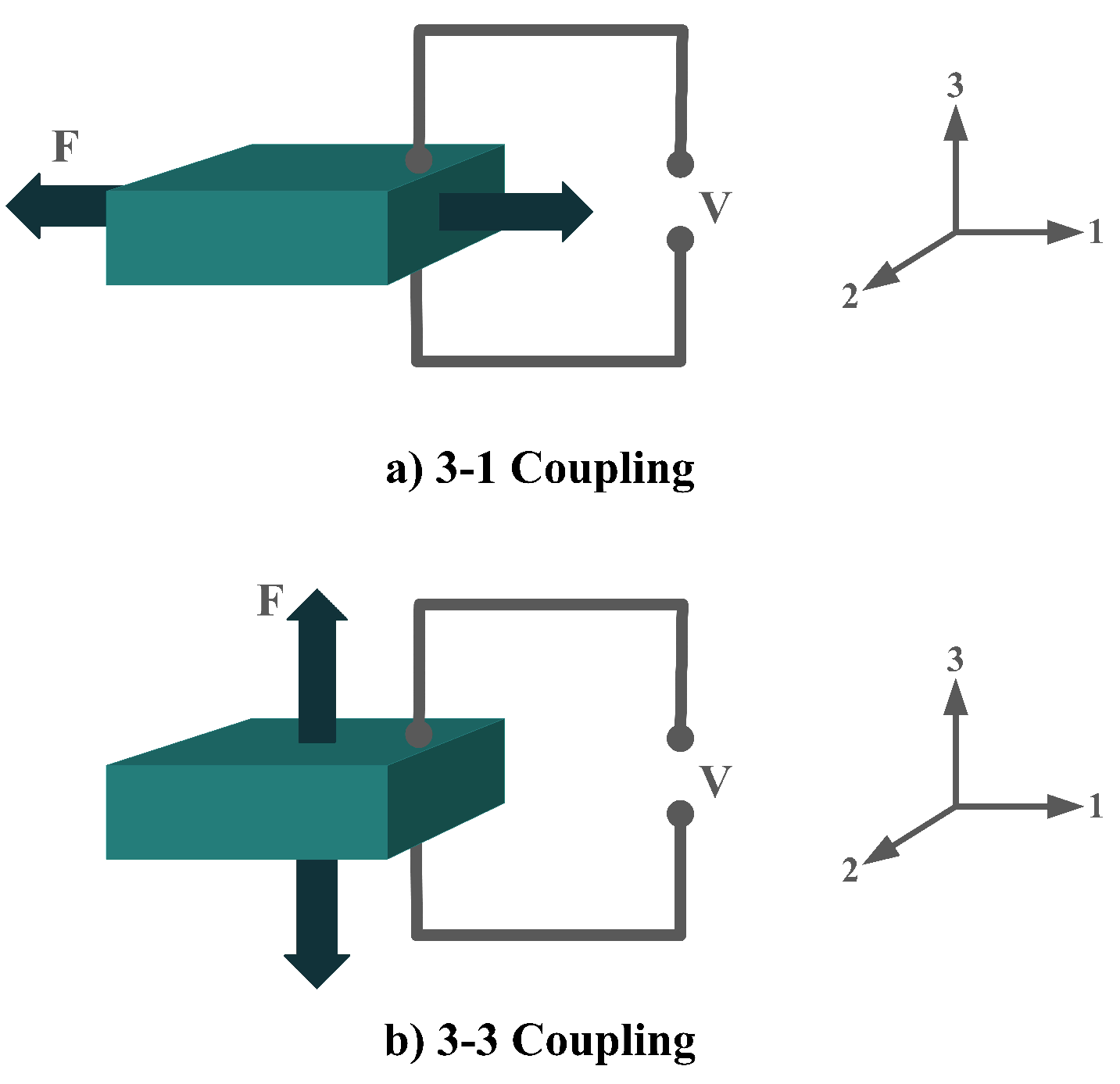

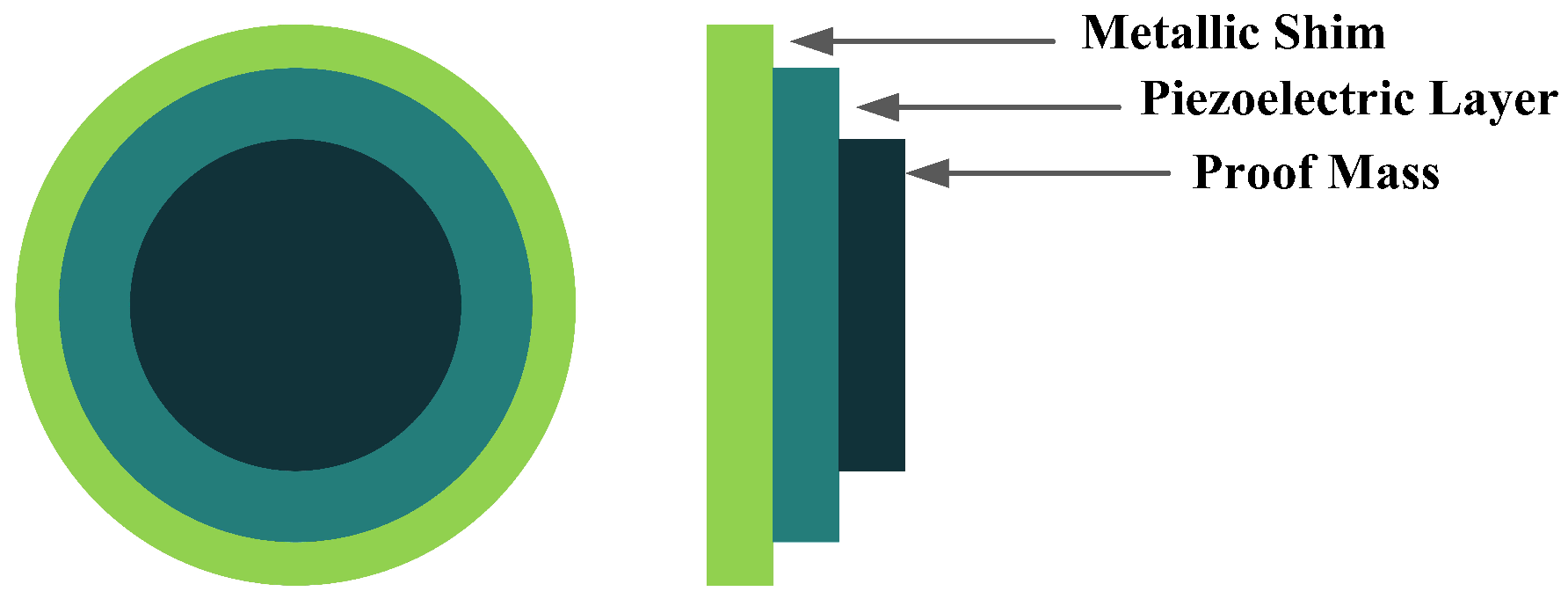
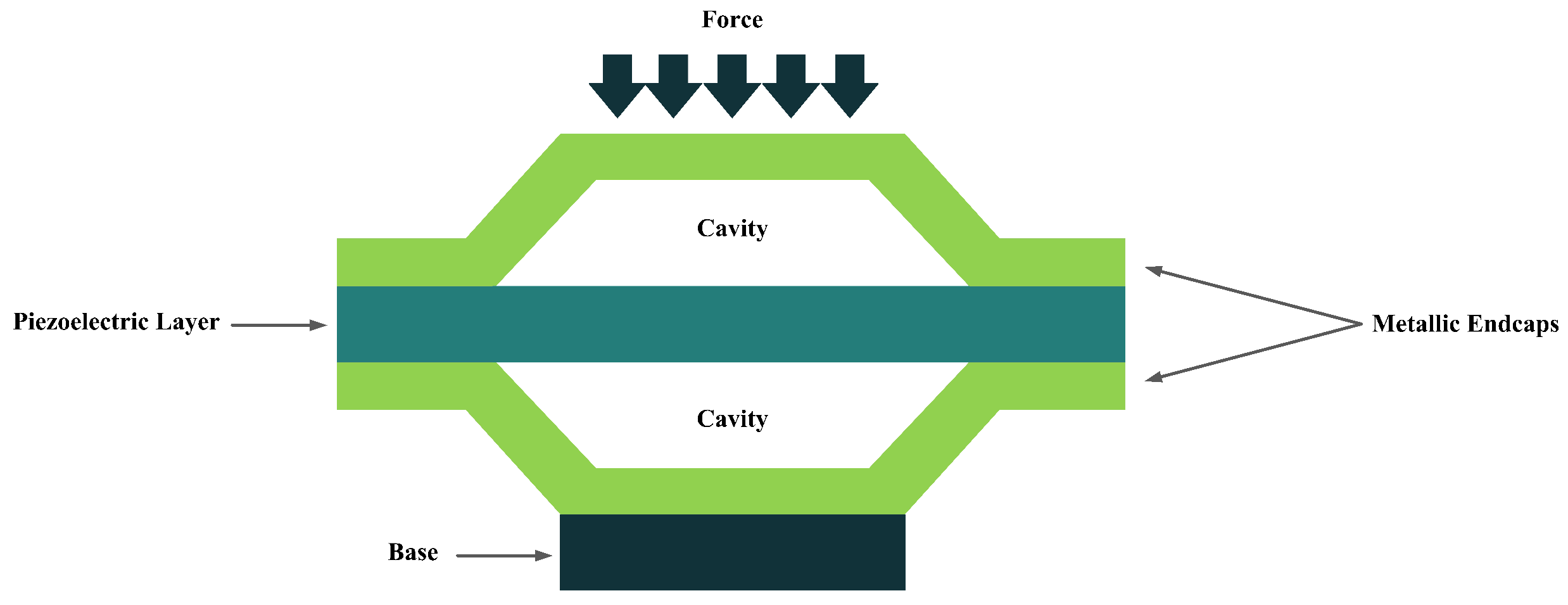
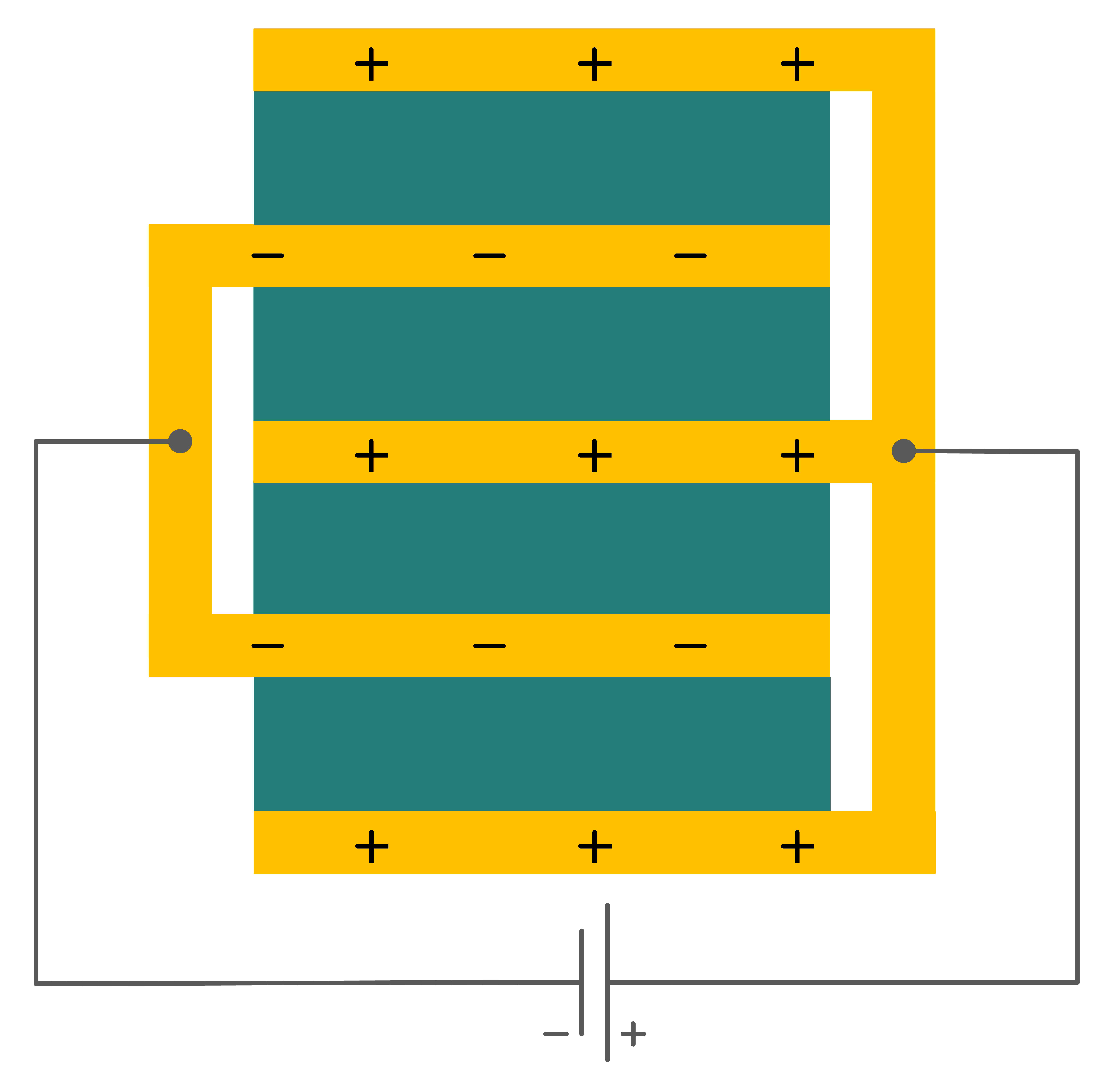





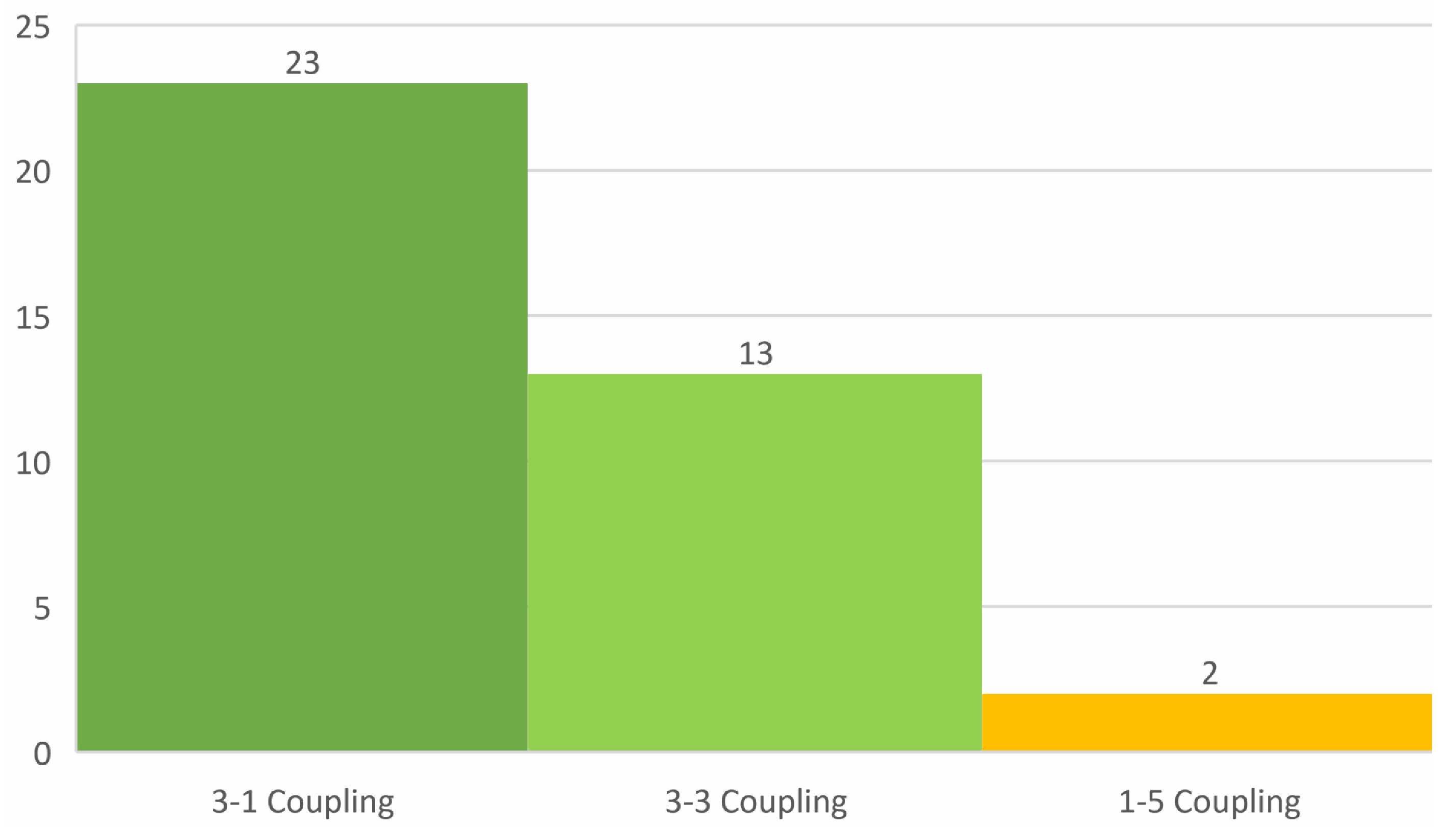


| Color | Meaning |
|---|---|
 | Buoy |
 | Magnet |
 | Piezoelectric Layer |
 | Water |
| The Other Colors | Non-Piezoelectric Material |
| Year and Reference | Material | Coupling Mode | Location | Power Density (W/m3) | Energy Source | Schematics |
|---|---|---|---|---|---|---|
| 1987 [52] | PVDF | 3-1 | Onshore | - | Wave Motion |  |
| 1987 [53] | PVDF | 3-3 | - | - | Wave Motion |  |
| 2001 [54] | PVDF | 3-1 | - | - | Water Current | 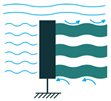 |
| 2004 [55] | PVDF | 3-1 | - | - | Water Current | 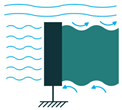 |
| 2004 [55] | PZT | 3-1 | - | 70.00 | Water Current |  |
| 2007 [25] | PVDF | 3-1 | Onshore | - | Water Current | 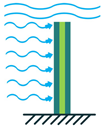 |
| 2009 [56] | - | - | Offshore | 1.64 | Wave Motion |  |
| 2010 [57] | PVDF | 3-3 | Offshore | 15.00 | Water Current | 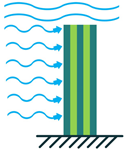 |
| 2011 [58] | PVDF | - | Offshore | 4.00 × 10−3 | Water Current |  |
| 2012 [59,60] | PVDF | - | Offshore | 0.42 | Wave Motion- Water Current |  |
| 2012 [61] | - | - | - | 1.56 × 10−4 | Water Current |  |
| 2012 [62] | PZT | 3-1 | Onshore | 0.17 | Wave Motion | 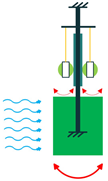 |
| 2013 [63] | PZT | 3-3 | - | 0.84 | Water Current |  |
| 2013 [64] | PZT | - | - | 366.00 | Wave Motion |  |
| 2014 [65] | PZT | - | Offshore | 75.00 | Wave Motion | 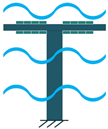 |
| 2014 [66] | PZT | 3-3 | - | 4.74 | Wave Motion |  |
| 2014 [67] | PVDF | 3-1 | - | - | Water Current |  |
| 2015 [68] | MFC | 3-1 | - | 1.16 × 10−2 | Water Current |  |
| 2015 [69] | PZT | 3-1 | - | 2.24 × 10−2 | Water Current |  |
| 2015 [70] | PZT | - | - | - | Water Current |  |
| 2015 [71] | PVDF | - | - | - | Water Current |  |
| 2015 [72] | PVDF | 3-1 | - | 1.65 × 10−4 | Water Current |  |
| 2015 [73] | PZT | - | Near/Offshore | 1.27 | Wave Motion |  |
| 2015 [74] | - | - | Nearshore | 3.50 × 10−10 | Wave Motion |  |
| 2015 [75] | MFC | - | - | 6.10 × 10−3 | Water Current |  |
| 2016 [76] | PZT | 3-1 | - | 17.31 | Water Current |  |
| 2016 [77] | PZT | 3-3 | Near/Offshore | 206.00 | Wave Motion |  |
| 2016 [78] | PVDF | - | - | 0.58 | Water Current |  |
| 2016 [78] | PZT | - | - | 0.58 | Water Current |  |
| 2016 [79] | PVDF | 3-1 | Near/Offshore | - | Wave Motion |  |
| 2017 [80] | PVDF | 3-1 | Near/Offshore | 2.60 × 10−12 | Water Current | 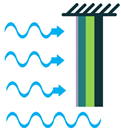 |
| 2017 [81] | PZT | - | - | 1.40 | Water Current | 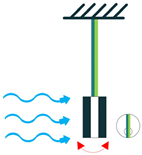 |
| 2017 [82] | PZT | - | - | 1.59 × 104 | Wave Motion | 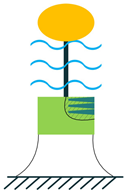 |
| 2017 [83] | PZT | - | - | 143.54 | Wave Motion |  |
| 2017 [84] | PZT | 3-3 | On/Near/Offshore | 260.00 | Wave Motion |  |
| 2017 [85,86] | PZT | 3-1 | - | 3.50 × 10−8 | Water Current |  |
| 2018 [87] | PZT | 3-1 | - | - | Wave Motion |  |
| 2018 [88] | PZT | - | Offshore | 10.34 × 103 | Wave Motion |  |
| 2018 [89] | - | 3-3 | - | 2.40 × 103 | Wave Motion |  |
| 2018 [90] | MFC | 3-1 | - | - | Water Current |  |
| 2018 [91] | - | - | - | 2.56 | Water Current |  |
| 2019 [92] | - | - | - | - | Wave Motion |  |
| 2019 [93] | PZT | 3-3 & 1-5 | - | 0.14 | Water Current |  |
| 2019 [94] | PZT | 3-3 | Offshore | 477.00 | Wave Motion |  |
| 2019 [95] | PZT | 3-1 | - | - | - |  |
| 2019 [96] | PZT | - | Nearshore | 1.06 × 104 | Wave Motion |  |
| 2019 [24] | - | 3-1 | Onshore | - | Wave Impact |  |
| 2019 [97] | PVDF | 3-1 | Offshore | 2.00 × 10−7 | Wave Motion |  |
| 2019 [98] | - | - | - | - | Water Current |  |
| 2019 [99] | MFC | - | - | 7.58 × 10−9 | Water Current |  |
| 2019 [100] | MFC | - | - | - | Water Current | 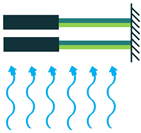 |
| 2019 [101] | PZT | - | - | - | Water Current | 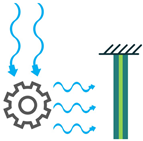 |
| 2019 [102] | PZT | - | Offshore | 140.00 | Wave Motion |  |
| 2020 [103] | PVDF | - | - | - | Water Current | 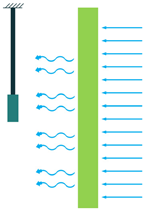 |
| 2020 [104] | PZT | 3-1 | - | 7.34 × 10−2 | Water Current |  |
| 2020 [105] | MFC | - | - | - | Water Current |  |
| 2020 [106] | PZT | - | - | - | Wave Motion |  |
| 2020 [107] | PVDF | - | - | - | Water Current |  |
| 2020 [108] | PZT | - | - | 5.74 × 10−8 | Water Current |  |
| 2021 [109] | - | - | - | 12.90 | Wave Motion |  |
| 2021 [110] | PZT | - | - | 8.42 × 10−4 | Water Current |  |
| 2021 [111] | PZT/PVDF | - | Near/Offshore | 10.50 × 102 | Wave Motion |  |
| 2021 [112] | MFC | 3-1 | - | 10.74 × 102 | Water Current |  |
| 2021 [113] | PVDF | 3-1 | - | - | Wave Motion |  |
| 2021 [114] | PZT | - | - | 3.58 × 10−2 | Water Current |  |
| 2021 [115] | - | - | - | 3.20 × 10−3 | Wave Motion |  |
| 2021 [116] | PZT | - | - | 1.63 | Wave Motion |  |
| 2021 [117] | - | - | - | - | Wave Motion |  |
| 2021 [118] | PZT/MFC | - | - | 62.00 × 103 | Wave Motion |  |
| 2021 [119] | PZT | - | Offshore | - | Wave Motion |  |
| 2021 [120] | PZT | - | - | - | Wave Motion |  |
| 2021 [121] | - | - | Nearshore | - | Wave Motion |  |
| 2021 [122] | MFC | 3-3 | - | 8.50 × 10−3 | Wave Motion |  |
| Year and Reference | Material | Coupling Mode | Location | Power Density (W/m3) | Energy Source | Schematics |
|---|---|---|---|---|---|---|
| 2010 [123] | PVDF | 3-1 | - | 1.90 × 10−2 | Water Current |  |
| 2011 [124] | PZT | 1-5 | - | 7.25 × 10−5 | Water Current |  |
| 2013 [125] | PZT | - | Offshore | 0.34 | Water Current |  |
| 2013 [126] | PZT | - | Offshore | - | Wave Motion | 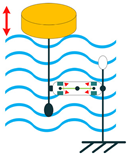 |
| 2013 [127] | PZT | - | Offshore | - | Wave Motion | 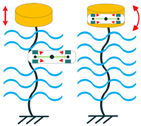 |
| 2018 [128] | PZT | 3-3 | - | - | Water Current |  |
| 2019 [129] | PVDF | - | - | 5.68 × 10−2 | Wave Motion |  |
| Year and Reference | Material | Coupling Mode | Location | Power Density (W/m3) | Energy Source | Schematics |
|---|---|---|---|---|---|---|
| 2013 [50] | PVDF | 3-3 | - | - | Wave Impact | 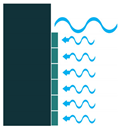 |
| 2017 [130] | PZT | - | Offshore | 600.00 | Wave Impact |  |
| 2021 [131] | PZT | - | - | - | Wave Motion | 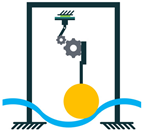 |
| Year and Reference | Material | Coupling Mode | Location | Power Density (W/m3) | Energy Source | Schematics |
|---|---|---|---|---|---|---|
| 2010 [132] | PZT | 3-3 | - | 25.26 | Water Current |  |
| 2021 [133] | PZT | - | - | 20.38 | Water Current |  |
| Type of Configuration | nW | µW | mW | W | kW |
|---|---|---|---|---|---|
| Cantilever Beam | - | ■ | ■ | ■ | ■ |
| Diaphragm | ■ | ■ | ■ | - | - |
| Stacked | - | ■ | ■ | - | - |
| Cymbal | - | ■ | ■ | - | - |
| Type of Material | Young’s Modulus (GPa) | d31 (×10−12 m/V) | k31 | Dielectric Constant |
|---|---|---|---|---|
| PZT | 62 | 320 | 0.44 | ~3800 |
| PVDF | 2–4 | 23 | 0.12 | ~12–13 |
| MFC | 16 | 170 | - | - |
Publisher’s Note: MDPI stays neutral with regard to jurisdictional claims in published maps and institutional affiliations. |
© 2022 by the authors. Licensee MDPI, Basel, Switzerland. This article is an open access article distributed under the terms and conditions of the Creative Commons Attribution (CC BY) license (https://creativecommons.org/licenses/by/4.0/).
Share and Cite
Kargar, S.M.; Hao, G. An Atlas of Piezoelectric Energy Harvesters in Oceanic Applications. Sensors 2022, 22, 1949. https://doi.org/10.3390/s22051949
Kargar SM, Hao G. An Atlas of Piezoelectric Energy Harvesters in Oceanic Applications. Sensors. 2022; 22(5):1949. https://doi.org/10.3390/s22051949
Chicago/Turabian StyleKargar, Seyyed Masoud, and Guangbo Hao. 2022. "An Atlas of Piezoelectric Energy Harvesters in Oceanic Applications" Sensors 22, no. 5: 1949. https://doi.org/10.3390/s22051949






